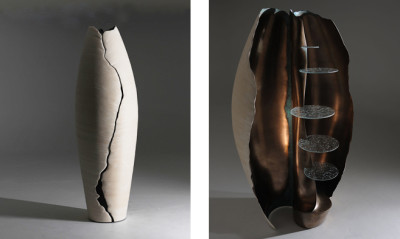Cabinets of curiosity
Share


Contemporary cabinets can be extraordinary works of art. These days, home owners are shopping for glamorous and intriguing-looking cabinets, worthy of the personal treasures they would hide or reveal, says FUNKE OSAE-BROWN.
As Omotola walked into her friend’s living room that warm Tuesday evening in February, she saw a moulded circular piece on the wall. “What’s that hanging on your wall?” she asked.
“It is a Chartres cabinet by Antwerp-based Studio Job,” her friend replied.
“It is unbelievable this is a cabinet,” Omotola said, while moving closer to the wall to admire the piece.
Chartres cabinet is a large, up-ended cabinet that comes with pinnacles of elevations. It is a dramatic architectural design that opens to expose an interior storage space where collectors can keep precious objects.
Something interesting is happening in the world of cabinet making as furniture makers are producing exquisite designs that stretch an idea and execution of a design into the realms of contemporary art and sculpture. The level of detailing used in manufacturing cabinets with bronze is extraordinary. They are showing great courage and gut in the way they are pushing the boundaries artistically.
“The Chartres was really captivating that day I saw it at my friend’s place,” explains Omotola, “I was impressed by its extraordinary shape and the intricate craftsmanship. It had some kind of emotive presence that got me drawn in.”
Marc Fish’s Babel cabinet is another creative statement piece that has changed the way cabinets are perceived. The Babel cabinet is inspired by intricate shell structures. It is a tall structure that gives the impression of how life is lived under sea. It comes with a double door with a textured-sycamore surface slithering to reveal a metal upright glass shelves.
Babel cabinet is fashioned after a seed pod or shell that makes it an organic cabinet to have. It is a brilliant way of taking cabinet-making to a wholly different level. Named after the biblical Tower of Babel, Babel, a 2013 piece by Fish is made of sycamore, glass and carbon fibre, bronze and textured glass and comes in a limited edition of five pieces.
“While Marc’s piece has no religious meaning or based on a religious belief,” Fish says of the piece on its website, “it does have a strong narrative representing the achievements of the human race, even with cultural, religious and language barriers. The cabinet, which follows on from Mollusque and Nautilus, gets its inspiration for shape from shell structures. The doors overlap, representing unity, the coming together of people.”

According to FT’s ‘How to Spend It,’ the technique used in making Babel cabinet involves micro-stack-lamination of the sycamore, which is moulded and bent, then carved and lined in copper. The designer’s ability to manipulate the wood in a wholly new way is amazing.
Historically, cabinets have always been important pieces of furniture. Hence, home owners in this century are shopping for glamorous and intriguing-looking cabinets, worthy of the personal treasures they would hide or reveal. It is for this reason that cabinets have remained popular through the centuries.
These days, collectors want cabinet designs that are works of art in themselves. Previously, cabinets are regarded as functional pieces that are containers to store precious objects. Now, they need to look as fabulous as their contents. It is now fashionable to own these rare works of art.
Historically, these statement pieces are part of a long tradition and they are often called cabinets of wonder or curiosity. It is a coinage popular in the 16th Ccentury England when they were used to keep baffling array of objects that show the home owner’s connoisseurship. This usually arouses a sense of awe in any one who visits such homes.
Another interesting design is the Organ cabinet. It comes in a limited edition of eight pieces and it is created by Swiss-born Paris-based designer Mattia Bonetti. The interesting piece looks like a glossy, lacquered cabinet hovering above shiny pipe work. It is inspired by a church organ.
Eye-catching cabinets is somewhat becoming something of an obsession for those who love unique cabinet design. In addition, designers are redesigning traditional cabinetry techniques, shapes and materials that are getting collectors excited.
Some designers are taking a different approach to cabinet making. Some are using exotic hardwoods to handcraft the sculptural form of the cabinet birthing eye-catching designs. Some of these modern designs are showing that there are no restrictions on the creative process.
“Some new designs of cabinets are very interesting,” says Tope Adebowale, a home décor designer. “Some of the latest designs are simple shapes yet interesting pieces to have in the home. They are for collectors who love unique designs, who don’t want designs that are commonplace.”
According to Adebowale, some of the designs she saw when she travelled to Europe last year include Bonetti’s cubist-inspired Trésor. A cabinet embellished with gilded and nickled brass on a eucalyptus and birch veneer, brings to mind the work of artist Piet Mondrian. The Naive’s Fiancé a cabinet designed by Algerian-born, Paris-based designer Taher Chemirik was among the pieces she viewed.
The Naive’s Fiancé is inspired by a knight in a parade outfit with a hexagonal base, brass grid and moss agates, plus roundels and rectangles in wood.
To her, the piece is firm in structure, yet lyrical in the decoration of copper flowers and semiprecious stones. Standing the two cabinets side by side highlights their differences and similarities. The main link between them is a wheat stalk, a symbol of fertility, which Naive wears on her hip and Fiancé as a belt.





